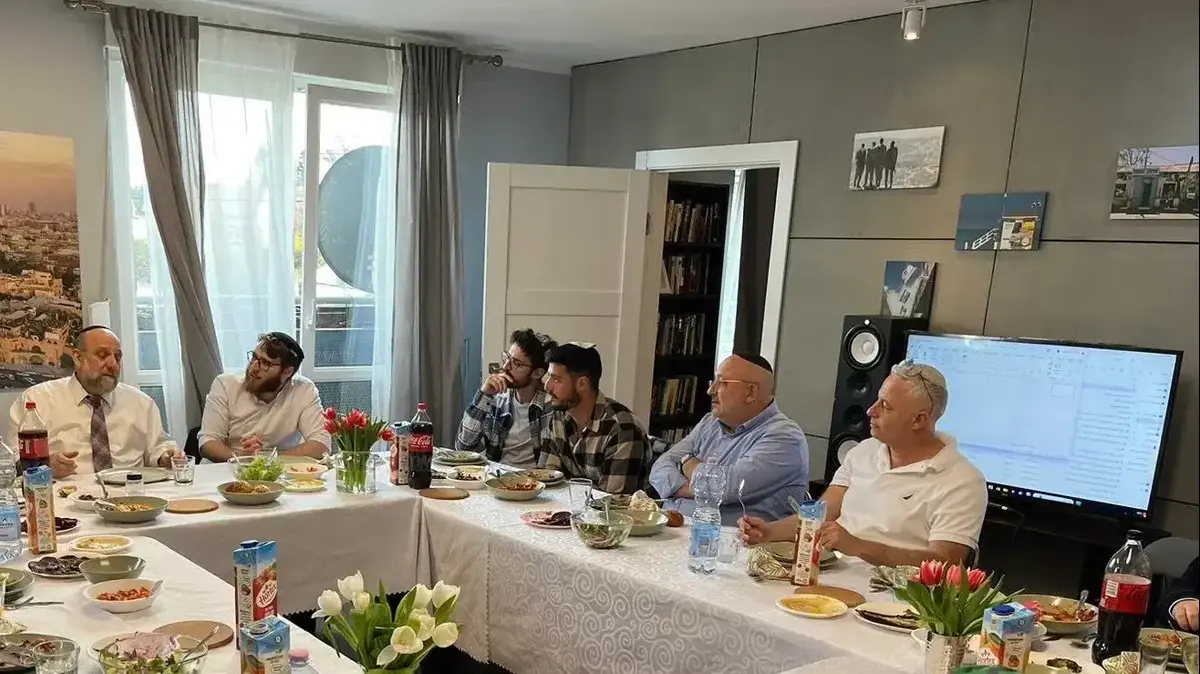The SA men were already carrying the petrol cans in their hands when they appeared in front of the synagogue on the morning of November 10, 1938.
The fact that the small half-timbered building in Bodenfelde in Lower Saxony survived the pogrom night is thanks to the persuasiveness of a local resident.
And the concern that a fire in the densely built-up street could spread to neighboring buildings.
That did not mean salvation for the synagogue.
Their decline began after the war: the new owner had windows walled up, stairs and gallery torn down.
A wooden gate - wide enough for a tractor - replaced the front door.
Wall and ceiling paintings took care of the drawing in moisture.
The center of Bodenfeldes Jewish community, built in 1825, ended up as a shabby barn.
The Central Council of Jews in Germany assumes 2,800 German synagogues and prayer rooms for the time of Hitler's accession to power.
Around half fell victim to the Nazi terror.
Many synagogues survived war and pogroms, but not the ignorance and repression of post-war Germans.
Hundreds of synagogues in the Federal Republic and GDR were only demolished after 1945 - to make room for office and residential buildings or parking spaces.
Or because no one was found to look after them.
A number of other centers of former Jewish community life were repurposed and rebuilt:
A paint, wallpaper and carpet dealer set up his storage room
in the synagogue in
Stadthagen
,
Lower Saxony
.
The Jewish community center in
Ermreuth
,
Franconia
, became a tool shed.
The building, which once
provided space for
around 200 members of the Jewish community in the Swabian town of
Hainsfarth
, switched between a workshop, a gym and a warehouse for building materials after the war.
In the former center of the Jewish community in
Rendsburg
in Schleswig-Holstein
, fish was smoked for decades.
The baroque synagogue of
Haigerloch
in Baden-Württemberg served first as a cinema, then as a food market, and finally as a textile warehouse.
Many other synagogues were taken over as horse stables, fire stations or by local parishes.
Despite all the differences in use after 1945, the recklessness of the new owners was similar: galleries were demolished, the arched windows typical of synagogues bricked up, ornaments painted over and sacred inscriptions removed.
In doing so, the builders did not just drive pragmatism.
Often the renovation was about deliberately destroying the Jewish heritage.
Often synagogues saved only consideration for the neighbors
This is shown by studies like that of Thea Altaras.
In her book "Synagogues in Hessen - What Happened Since 1945?"
The Jewish architect wrote in 1988: Mainly, "emphasis was placed on the rapid removal of any structural features of the once Jewish cult building" and the new use was secondary.
Altaras, who died in 2004, reported a destruction of "terrifying dimensions".
In Hesse alone, 223 of 363 synagogues survived the Nazi era, 59 were demolished after the war.
Most of the others fell into disrepair or were so heavily rebuilt that nothing remained of their Jewish character.
Joachim Hahn also deals with synagogues during the Nazi era and after 1945.
"The night of the pogrom mainly affected city synagogues. They were burned to the ground," explains the pastor and author, who has published several books on Jewish history in southern Germany since the early 1980s.
In the countryside, many buildings only survived out of consideration for the neighbors, as in Bodenfelde: "Because the streets were often very narrow, it was too dangerous to burn down the synagogues."
Another reason: "In 1938 a considerable part of the buildings was no longer used as synagogues," says Hahn.
The decline of Jewish communities began long before that: due to increasing persecution, many Jews had already left their homeland or were forced to sell synagogues at ridiculous prices.
The
synagogue, built
in
Esslingen
near Stuttgart in
1819,
escaped destruction as a home for the Hitler Youth and the Association of German Girls.
The synagogue in
Gedern
,
Hesse
, which was converted into a residential building and café after the war, probably owes its existence to its rededication as a prisoner of war camp.
However, "Aryanizations" were not a guarantee of being spared from the Nazi terror, says Hahn: "The SA and SS troops often took on former synagogues anyway - because they didn't know or because they didn't care."
Ignorance for decades
Bodenfeld's Jewish community had also left their small half-timbered synagogue before the November pogroms of 1938.
A shoemaker used it as a workshop.
The last Bodenfelder Jews migrated to Palestine in 1937.
For a long time, those who wanted to see testimonies to their church life had to travel to a synagogue in Haifa, Israel.
There the last head of the community managed to take one of the Torah scrolls with him.
Decades passed before Germany began to think about the preservation of its Jewish heritage.
In the meantime there have been numerous studies such as the online project "Alemannia Judaica" or "More than Stones", a series of commemorative volumes on Jewish communities in Bavaria that have been published by art and church historians since 2007.
They show that the ignorance of Jewish history was not limited to the post-war confusion in West and East Germany.
In 1974, a former synagogue in
Großen-Linden
near Gießen was demolished, where a farmer built an asphalt yard as the owner.
The synagogue in
Gunzenhausen
,
Bavaria
, built in 1883 in the neo-Romanesque style with two imposing oriental onion domes, survived the Nazi era as a prisoner of war camp and in the decades that followed it became a department store and workshop;
It was only demolished in 1981 - in favor of an underground car park entrance.
In many other cases, such as a synagogue that has been converted into a stable in
Neidenstein
(Baden-Württemberg), committed citizens still insist on dignified interactions in vain.
Today, however, thoughtlessness and forgetting of history are no longer the rule.
In many places where synagogues have been demolished, memorial plaques now remind of this.
Churches, initiatives and Jewish communities are often committed to turning barns, warehouses or cowsheds into worthy places of remembrance and cultural encounters.
New domicile 30 kilometers away
In
Ahrweiler
in Rhineland-Palatinate, for example,
a group of schoolchildren ensured that a synagogue, which was used as a fertilizer warehouse, is now a permanent exhibition on the city's Jewish history.
In
Freudenthal
,
Baden-Württemberg
, the municipal council had already decided to tear down the synagogue, which had been converted into a gymnasium, when an initiative group was founded to preserve it.
After renovation work it became a "Pedagogical-Cultural Center".
In many cases, Jews are now praying and learning again in synagogues that were believed to be lost:
The
Jewish community building, built
in
Berkach
,
Thuringia, in 1852,
became the storage room and forge of the local LPG after 1945.
After extensive restoration, Jewish services have been held several times a year since the early 1990s.
The small synagogue in
Wohra
,
Hesse
, was forgotten as a storage room.
It has been home to Giessen's Jewish community since 1995.
The
Lübeck
synagogue, built in 1880 in the "Moorish" style,
survived the pogroms of 1938 and two arson attacks in the 1990s.
After a long reconstruction, it should be available to the Jewish community again this year.
More on this in SPIEGEL HISTORY 4/2019
Photo: DER SPIEGEL
DER SPIEGEL STORY 4/2019: Jewish life in Germany
contents
Order from Amazon
Find it at MyKiosk
SPIEGEL HISTORY by subscription
There was also a happy ending in Bodenfelde, through the newly awakened Jewish community life and through individual engagement: Detlev Herbst went on a search for clues with students in the 1980s and came across the completely ailing, forgotten half-timbered building.
The now retired teacher made sure that the history of the synagogue was reconstructed - and that the building was also reconstructed.
The Jewish community of Göttingen, revived in the early 1990s, had the house dismantled and rebuilt 30 kilometers away.
The Bodenfeld synagogue in Göttingen was inaugurated for the second time on November 9, 2008: exactly 70 years after SA men with petrol cans appeared in front of it.
Icon: The mirror









